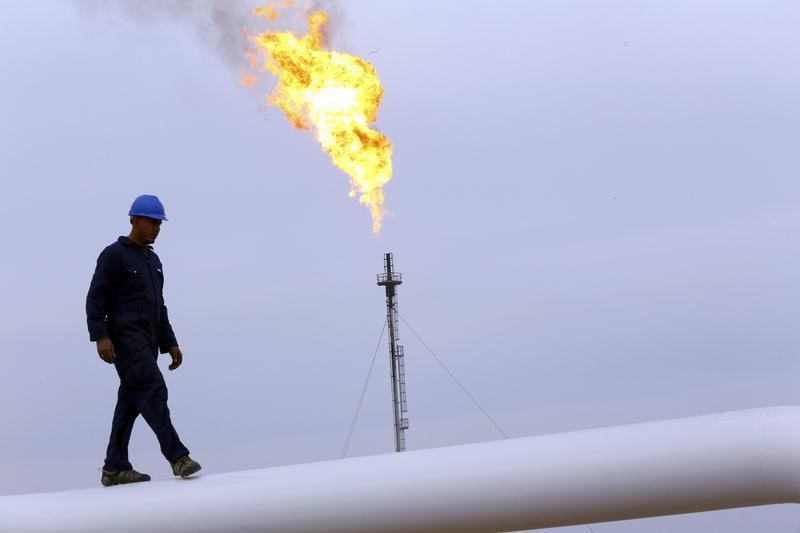By Barani Krishnan
Investing.com — Crude prices struggled again to keep up with their huge weekly opening rally triggered by the OPEC+ announcement on production cuts, as a U.S. weekly inventory report on Wednesday showed the government had drawn down reserves again to add to market supply and limit fuel price hikes.
Also weighing on oil was data showing U.S. in March came in at less than 44% of the previous month, emitting potential recession signals even as it indicated relief for inflation fighters at the Federal Reserve who said employment and wage growth have to cool to curb the worst price pressures in four decades.
U.S. crude stockpiles fell sharply for a second week in a row, accompanied by large drawdowns as well in gasoline and distillates inventories as domestic refiners prepared for busy summer travels, weekly government data showed.
in storage fell by 3.739 million barrels during the week ended March 31, the U.S. Energy Information Administration, or EIA, said in its Weekly Petroleum Status Report. Analysts tracked by Investing.com had expected the EIA to report a crude balance decline of 2.329M barrels instead. In the previous week to March 24, crude stockpiles tumbled by 7.489M barrels.
Within the latest weekly EIA report was, however, a line showing a draw of 3.7M barrels from the Strategic Petroleum Reserve, or SPR.
It was the first SPR draw for this year, although it was scheduled late last year as part of the 2022 budget.
The Biden administration has leaned on the reserve heavily since late 2021 to offset tight crude supplies that had raised fuel costs for Americans. As of last week, the SPR’s crude balance was at its lowest since November 1983.
“The latest EIA report is definitely positive on all fronts but crude bulls were probably tempered in their ardor by the SPR draw, which like a nemesis has returned to haunt the longs in the market,” said John Kilduff, partner at New York energy hedge fund Again Capital.
“Of course, the administration cannot use the SPR like before, and it won’t be a threat to the crude balance situation like last year,” Kilduff said. “Yet, the SPR is like a nemesis to oil bulls. They just hate it and it’s probably why the market did not really take off in a big way right after the data.”
New York-traded , or WTI, crude settled down 10 cents, or 0.1%, at $80.61 a barrel. In the previous session, WTI added just 29 cents, or 0.4%. The U.S. crude benchmark has struggled to advance since Monday’s 6.3% rally on the back of plans by OPEC+ to reduce another 1.7 million barrels daily from output, on top of existing cuts of 2.0 million barrels per day imposed since November.
crude settled up 5 cents, or 0.1%, after rising just a penny on Tuesday. Like WTI, Brent had gained 6.3% on Monday.
On the front, the EIA cited a drawdown of 4.119M barrels versus the forecast drop of 1.729M barrels, and against the previous weekly decline of 2.904M barrels. Automotive fuel gasoline is the No. 1 U.S. fuel product.
With , the EIA reported a 3.632M barrel draw, against expectations for a drop of 0.396M barrels and versus the prior week’s build of 0.218M. Distillates, which are refined into , diesel for trucks, buses, trains and ships and fuel for jets, had been the strongest demand component of the petroleum complex earlier in the year.
On the U.S. employment front, company hirings rose by just 145,000 last month versus the February growth of 261,000 in February, private payrolls processor ADP said, releasing a number even below the 210,000 growth forecast on the average by economists polled by US media.
“Our March payroll data is one of several signals that the economy is slowing,” Nela Richardson, chief economist at the ADP, said in a statement. “Employers are pulling back from a year of strong hiring and pay growth, after a three-month plateau, is inching down.”
The private hirings data came on the heels of another report on US job openings for February, which showed the smallest growth in almost two years. Job openings slipped to 9.9 million, growing at their slowest pace since May 2021, the Labor Department said in that report.
The two reports made print before Friday’s scheduled release of the all-important labor update for the United States: The non-farm payrolls, or NFP, report.
The March edition of the NFP is expected to show a growth of just 240,000 versus February’s 311,000. If correct, it could be sharply lower than January’s 517,000 spike that raised new worries about inflation in the United States.
Inflation, as measured by the CPI, or , hit 40-year highs in June 2022, expanding at an annual rate of 9.1%. Since then, it has slowed, growing at just 6.5% per annum in February, for its slowest expansion since October 2021. Even so, that was more than three times the Fed’s target of 2% per annum.
The Fed has increased interest by 475 basis points over the past 13 months, taking them to a peak of 5% from just 0.25% after the COVID-19 outbreak in March 2020.
The central bank’s main guide for rates has been the monthly NFP report. The labor market has been the juggernaut of US economic recovery from the pandemic, with hundreds of thousands of jobs being added without fail since June 2020 to make up for the initial loss of 20 million jobs to the pandemic. The Fed has identified robust job and wages growth as two of the key drivers of inflation. Average monthly wages have grown without a stop since May 2021.
Read the full article here
















